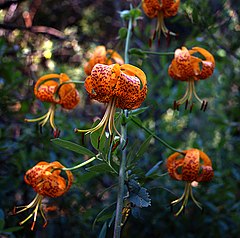Lilium pardalinum
| Lilium pardalinum subsp. var. | leopard lily, panther lily | |||||||||||||||||||||||||||||||||||||||||||||||||||||||
|---|---|---|---|---|---|---|---|---|---|---|---|---|---|---|---|---|---|---|---|---|---|---|---|---|---|---|---|---|---|---|---|---|---|---|---|---|---|---|---|---|---|---|---|---|---|---|---|---|---|---|---|---|---|---|---|---|

|
|
| ||||||||||||||||||||||||||||||||||||||||||||||||||||||
| ||||||||||||||||||||||||||||||||||||||||||||||||||||||||
Lilium pardalinum, sometimes known as the panther lily or leopard lily, is a native of Oregon and California, where it usually grows in damp areas. Typically it grows to about two meters high, the tallest and most vigorous plants can reach up to 2.5 meters. The flowers are Turk's-cap shaped, red-orange, with numerous brown spots, usually flowering in July. The bulbs are small, and many are usually clustered together on a rhizomatous stock.
| Standard Cyclopedia of Horticulture |
|---|
|
Lilium pardalinum, Kellogg. Leopard Lily. Panther Lily. Bulb a scaly rhizome, quite similar to that of L. Parryi, but more branching and irregular in form: st. 3-6 ft. high, smooth, pale green: leaves horizontal, 3-4 in. long, 3/4 -l in. wide, usually in 3 or 4 whorls of 9-15 leaves each, with a few scattered ones above and below: flowers 1-30, 2-4 in. diam. with segms. reflexed to the St., about half of each one, at the base, is bright yellow, spotted brownish purple, while the remainder, at the end is bright orange-scarlet; anthers red. Late June to early Aug. Sierra Nevada Mts. of Calif. —This lily is the best and most easily grown Calif, species for general culture; hardy, robust, and permanent. Var. angustifolium, Kellogg, is identical, except the leaves are much narrower, and it is of more slender growth: it is sometimes confused with L. Roezlii. Var. californicum, Hort. (L. californicum, Lindl.), has smaller leaves, mostly scattered, and larger, more richly colored flowers. Var. pallidifolium, Baker (var. puberulum, Leicht), has paler green leaves and smaller, paler-colored flowers than those of the type, not so thickly spotted. Var. Robinsonianum, Moore, is a stronger grower than the type, sometimes 8-9 ft. high, with mostly scattered leaves and larger, more richly colored flowers Var. luteum, Hort., produces pure yellow flowers, spotted brownish purple; in other respects it is the same as the type.—There are also several other rather indistinct so - called vars. and unnamed hybrid between L.pardalinum and L.Humboldtii. Another hybrid between L. Pardalinum and L Parryi called L.Burbankii, Hort., produces flowers resembling those of the former color and the latter in size and shape. Closely allied to L pardalinum is L.parviflorum, Hook (L. Sayi, Nutt., L. pardalinum var. minus, Hort.), but the flowers, which are of the same color, are smaller and are solitary or 2 or 3 are borne together. June, July. Vancouver Isl. to N. Calif, along the sea-coast. Rather capricious under culture. CH
|
Cultivation
- Do you have cultivation info on this plant? Edit this section!
Propagation
By dividing bulbs, scales, planting bulbils and from seed; winter sow in vented containers, coldframe or unheated greenhouse (stratify if indoors).
Pests and diseases
- Do you have pest and disease info on this plant? Edit this section!
Species
There are five subspecies:[1][2]
- Lilium pardalinum ssp. pardalinum Kellogg -- leopard lily
- Lilium pardalinum ssp. pitkinense (Beane & Vollmer) Skinner, comb. nov. ined. -- Pitkin Marsh lily
- Lilium pardalinum ssp. shastense (Eastw.) Skinner -- Shasta lily
- Lilium pardalinum ssp. vollmeri (Eastw.) Skinner -- Vollmer's lily
- Lilium pardalinum ssp. wigginsii (Beane & Vollmer) Skinner, comb. nov. ined. -- Wiggins' lily
The subspecies Pitkin Marsh lily, Lilium pardalinum ssp pitkinese, is federally listed as an endangered species.
Gallery
If you have a photo of this plant, please upload it! Plus, there may be other photos available for you to add.
References
- Standard Cyclopedia of Horticulture, by L. H. Bailey, MacMillan Co., 1963
External links
- w:Lilium pardalinum. Some of the material on this page may be from Wikipedia, under the Creative Commons license.
- Lilium pardalinum QR Code (Size 50, 100, 200, 500)
Cite error:
<ref> tags exist, but no <references/> tag was found

